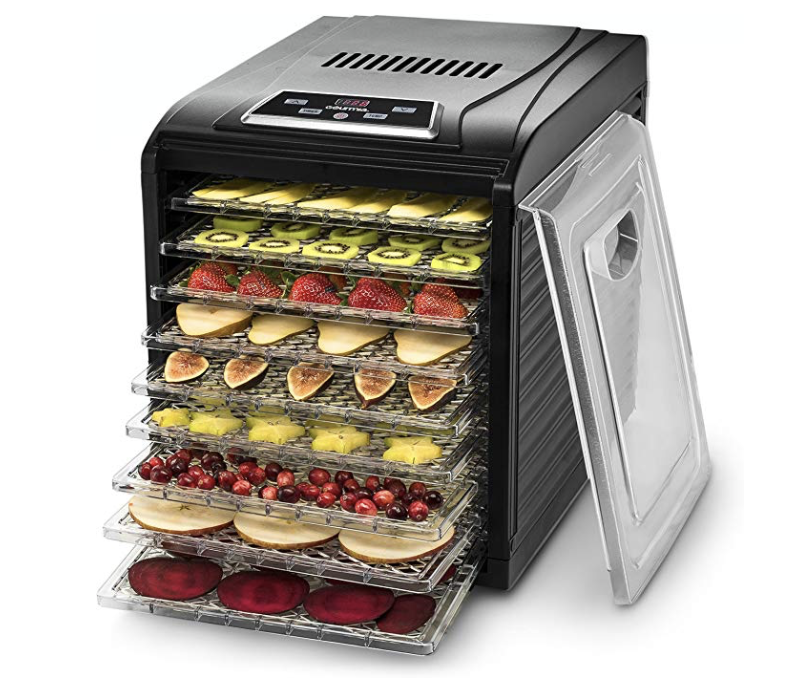Moisture in food encourages bugs and adds weight. Drying out food is an ancient and delicious way to preserve a wide variety of foods and – and for some crafts. As we view an uncertain future it’s a great idea to have fruit, vegetables and meat available that can be stored safely, snacked dry or dehydrated for cooking.
What’s so great about dehydrators?
You can use them to dry fruits from berries to bananas, or to make your own bird seed, potpourri and even yogurt (see below.) Dehydrators can be fantastically useful in preparing for an emergency situation.
When foods are dried and stored in an airtight container in a cool, dark location, they will keep indefinitely. This is great for emergency storage. This also makes a dehydrator a must for anyone with a garden. At harvest time, you can dry the excess and save it for months or even years without taking up much room in your pantry. The other options are canning and freezing, which are faster, but dried produce takes up less space than either of these, lasts longer than canned food, and, unlike freezing, dried foods don’t have to rely on a power source.
Food Dehydrator with Powerful Fan
The Excalibur is a food dehydrator with powerful top-mounted fan with 600 watts of drying power. It has an adjustable thermostat and four trays that provide four square feet of drying space.
Dried foods are especially good for outdoor enthusiasts. They are light and easy to carry. They are also high in calories and nutrition, allowing hikers, cyclists, etc. to keep going all day. Try putting them in the kid’s school lunches for the same reasons.
Many commercial dehydrators are round and made of stackable shelves with a heating element in the bottom, but square models with removable shelves are also available. Square dehydrators tend to be more efficient as they maintain a more consistent temperature and allow a greater amount of “head room,” making it possible to dry larger items. We have picked five of the Amazon expert group recommendations. They cover all options and types of dehydration and all price ranges.
For instance the Gourmia below has:
- 9 TRAY: Nine removable, non-stick trays provide plenty of room to dry anything from sweet pineapple slices to beef jerky! Bonus fruit leather sheet and drip tray included.
- DIGITAL DRY: Adjustable settings range from 95°F- 158°F. The back-mounted fan provides silent, consistent, airflow and heat circulation, for thorough drying without shelf rotation or overheating. When the timer has completed, the machine will ring and shut off automatically.
- TRANSPARENT DOOR: Door is clear for easy at a glance monitoring of all sheets.
It is also possible to dry foods in the open or in an oven. To dry foods without equipment, either outside or in an airy room, you must have temperatures of 90 degrees F or above, low humidity and an area free of insects. If you live in a climate that consistently offers these conditions, natural drying may be for you. Oven drying is possible, but inefficient because ovens require a lot power to operate and they only heat and do not remove moisture. Commercial food driers tend to work better than natural drying or ovens, both for production of a controlled temperature and efficient removal of moisture.
Preparation
Drying works best with ripe, unblemished produce. You may want to pre-treat food before drying. One method is “blanching,” which involves exposing fruit or vegetables to steam or boiling water and then cooling them quickly in a refrigerator or icebox. This will make produce last even longer in its dried state and is recommended for most vegetables. Another preparation technique is dipping, which keeps fruits from oxidizing when dried. Try dipping if it’s important to you that your banana chips are yellow and your peach rings peach. Use one cup of lemon juice in one quart of water, soak produce for up to 10 minutes and drain fruit before drying.
Rehydration
What many people don’t realize is that it’s possible to add water back into dehydrated foods. For fruits, just add boiling water. Use only enough to barely cover the fruit and wait for 10 minutes.
Dried vegetables should retain less water than dried fruits, so you’ll need more water and time to reconstitute them. Use about equal volumes of water and vegetables and allow the veggies to soak for up to three hours. Try to eat rehydrated foods quickly as they will spoil.
Make yogurt with a dehydrator
Add two cups powdered milk to one gallon reduced-fat milk. Scald for two seconds. Remove from heat and cool to around 115ºF. Add four tablespoons of non-pasteurized plain yogurt to the cooled milk. Pour into containers and cover. Incubate in a dehydrator at 115ºF until mixture takes your intended consistency, about five hours. Do not disturb, bump, open door or move the yogurt culture during incubation. When finished, refrigerate. Before serving, add flavors or fresh fruit, to taste.
